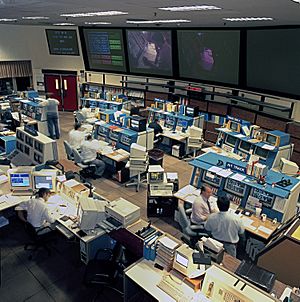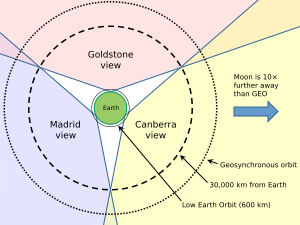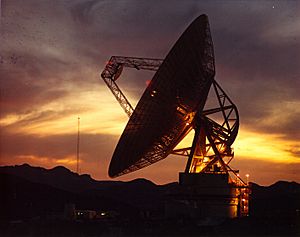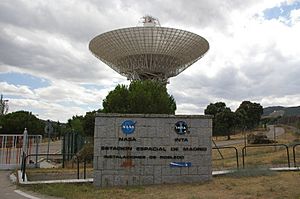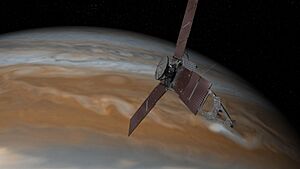NASA Deep Space Network facts for kids
Quick facts for kids Deep Space Network |
|||||||||
|---|---|---|---|---|---|---|---|---|---|
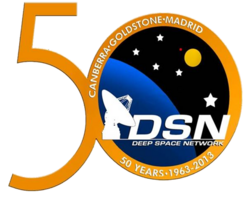
Insignia for the Deep Space Network's 50th anniversary celebrations (1963–2013)
|
|||||||||
| Organization | Interplanetary Network Directorate (NASA / JPL) |
||||||||
|
Coordinates
|
34°12′6.1″N 118°10′18″W / 34.201694°N 118.17167°W
|
||||||||
| Established | October 1, 1958 67 years ago |
||||||||
|
|||||||||
The NASA Deep Space Network (DSN) is a special worldwide system of giant antennas and equipment. It helps NASA talk to its spacecraft that are exploring space far beyond Earth. These facilities are located in three places: California in the United States, Madrid in Spain, and Canberra in Australia.
The DSN also uses its powerful antennas to study the Solar System and the wider universe using radio waves. Sometimes, it even helps with missions orbiting Earth. The DSN is a key part of NASA's Jet Propulsion Laboratory (JPL).
Contents
What is the Deep Space Network?
The DSN has three main communication centers around the world. They are placed so that at least one station can always "see" a distant spacecraft as Earth spins. This means NASA can stay in touch with its missions all the time.
The three locations are:
- The Goldstone Deep Space Communications Complex in California, USA. It's about 60 kilometers (37 miles) north of Barstow.
- The Madrid Deep Space Communications Complex in Spain. It's about 60 kilometers (37 miles) west of Madrid.
- The Canberra Deep Space Communication Complex (CDSCC) in Australia. It's about 40 kilometers (25 miles) southwest of Canberra.
Each center is built in a bowl-shaped area surrounded by hills. This helps block out other radio signals that could interfere with the DSN's sensitive equipment. This smart placement makes the DSN the biggest and most sensitive communication system for science in the world.
How the DSN Helps Space Missions
The DSN is vital for NASA's scientific exploration of the Solar System. It creates a two-way communication link. This link helps guide and control NASA's uncrewed space probes. It also brings back amazing images and new scientific information that these probes collect.
All DSN antennas are steerable, meaning they can point in different directions. They are also "high-gain" antennas, which means they can send and receive very weak signals over huge distances.
The DSN's antennas and data systems allow it to:
- Receive telemetry data (information about the spacecraft's health and what it's observing).
- Send commands to spacecraft, telling them what to do.
- Upload new software to spacecraft.
- Track a spacecraft's exact position and speed.
- Perform special observations called Very Long Baseline Interferometry.
- Measure changes in radio waves for science experiments.
- Collect important science data.
- Keep an eye on how the network itself is working.
Working with Other Space Agencies
Other countries and organizations also have their own deep space networks. The DSN works with them using shared rules set by the Consultative Committee for Space Data Systems. This means the DSN can cooperate with networks from other space agencies.
These include networks from China, India, Japan, and the European Space Agency (ESA). These agencies often work together to get better coverage for their missions. For example, the DSN and ESA have an agreement to use each other's networks. This makes missions more effective and reduces risks. Sometimes, large radio astronomy facilities like the Parkes Observatory in Australia are also used to help the DSN.
The Operations Control Center
The antennas at all three DSN centers send their information directly to the Deep Space Operations Center (DSOC). This center is located at the JPL facilities in Pasadena, California.
In the early days, the control center was not a permanent place. It was a temporary setup. But in 1961, NASA started building a permanent facility called the Space Flight Operations Facility (SFOF). It was finished in 1963.
Today, the people working at the SFOF watch and direct all DSN operations. They also make sure the data from spacecraft is good quality before sending it to scientists. A special ground communication system connects the three DSN centers to the SFOF at JPL. It also links to other space flight control centers and scientists worldwide.
Understanding Deep Space Communication
Talking to spacecraft in deep space is very different from talking to those in low Earth orbit (LEO). Deep space missions can be seen for long periods from many parts of Earth. This means only a few stations are needed, which is why the DSN has only three main sites. However, these few stations need huge antennas, super-sensitive receivers, and powerful transmitters. This is because they have to send and receive signals over incredibly vast distances.
The term "deep space" can mean different things. NASA once defined it as communicating with spacecraft traveling about 16,000 kilometers (10,000 miles) from Earth. JPL diagrams show that a spacecraft 30,000 kilometers (18,641 miles) away is always visible to one of the DSN stations. The International Telecommunication Union (ITU) defines "deep space" as starting at a distance of 2 million kilometers (1.24 million miles) from Earth.
Radio Frequencies for Space Communication
The NASA Deep Space Network can send and receive signals using different radio frequencies. These are called S-band (2 GHz), X-band (8 GHz), and Ka-band (32 GHz). Over time, the DSN has moved to using higher frequencies. Higher frequencies allow for more data to be sent back to Earth. However, they also require spacecraft to point their antennas more precisely. The DSN's antennas on Earth also need to be more accurate.
Early missions used S-band. The Viking mission in 1975 experimented with X-band. The Voyager missions in 1977 were the first to use X-band regularly. Similarly, the Mars Observer mission in 1994 tested Ka-band. The Kepler mission in 2009 was the first to use Ka-band as its main way to send data.
Not all space missions can use these "deep space" frequencies. Missions to the Moon or to special points like the Earth-Moon Lagrangian points are closer than 2 million kilometers (1.24 million miles) from Earth. They are considered "near space." These missions, like the James Webb Space Telescope, use a different frequency band called K-band (27 GHz). The DSN has been improved to receive these K-band signals, but it doesn't transmit on them.
The DSN is also exploring using light instead of radio waves for communication. This is called optical deep space communication. It could allow for much faster communication speeds. However, it is affected by weather and needs extremely precise pointing from the spacecraft. This technology is still being tested.
History of the Deep Space Network
The DSN started in January 1958. At that time, JPL set up portable radio tracking stations in Nigeria, Singapore, and California. Their job was to receive signals from Explorer 1, the first successful US satellite.
On October 1, 1958, NASA was officially created. Its goal was to bring together all the different space exploration programs in the US. On December 3, 1958, JPL became part of NASA. JPL was then given the job of designing and carrying out missions to the Moon and planets.
Soon after, NASA decided to create the Deep Space Network. It was designed to be a separate communication system that could support all deep space missions. This meant each mission wouldn't need to build its own communication system. The DSN was given the job of researching, developing, and operating its own systems. Because of this, it has become a world leader in creating advanced receivers, huge dish antennas, and systems for tracking and sending commands. The DSN officially began sending missions into deep space on Christmas Eve 1963. It has been working continuously ever since.
DSN and Spacecraft Emergencies
The DSN's largest antennas are often called upon during spacecraft emergencies. Most spacecraft are designed to use smaller, more efficient DSN antennas for normal operations. But during an emergency, using the biggest antennas is crucial. This is because a troubled spacecraft might not be able to use its full power. Also, if it has problems controlling its direction, it might not be able to point its main antenna correctly. In these situations, getting every tiny bit of data is super important to understand what's wrong and how to fix it.
A famous example is the Apollo 13 mission. The astronauts had limited battery power and couldn't use their main antennas. The signals were too weak for the regular Manned Space Flight Network. So, the DSN's biggest antennas (and the Parkes Observatory radio telescope in Australia) were essential for saving the astronauts' lives. The DSN also helps other space agencies in emergencies. For instance, the recovery of the Solar and Heliospheric Observatory (SOHO) mission by the European Space Agency (ESA) would not have been possible without the DSN's largest facilities.
DSN's Role in the Apollo Program
Even though the DSN usually tracks uncrewed spacecraft, it also helped with communication for the Apollo missions to the Moon. The main responsibility for Apollo was with the Manned Space Flight Network (MSFN). However, the DSN helped design the MSFN stations for lunar communication. It also provided a second antenna at each MSFN site. Two antennas were needed because the large antennas had narrow beams. They couldn't cover both the lunar orbiter and the lander at the same time. The DSN also provided some of its larger antennas when needed, especially for TV broadcasts from the Moon and for emergencies like Apollo 13.
In 1965, a plan called the "wing concept" was developed. This involved building a new section, or "wing," at the main building of each of the three DSN sites. This wing would have an MSFN control room and equipment. This setup allowed the DSN station to quickly switch between a deep-space mission and an Apollo mission. This way, the DSN could support both Apollo and its own deep space exploration goals without building even more antennas.
How the DSN is Managed
The DSN is a NASA facility. It is managed and operated for NASA by JPL, which is part of the California Institute of Technology (Caltech). The Interplanetary Network Directorate (IND) at JPL is in charge of developing and running the DSN.
The DSN facilities in Spain and Australia are owned and operated together with those countries' scientific organizations. In Australia, the Commonwealth Scientific and Industrial Research Organisation (CSIRO) manages the daily operations of the Canberra Deep Space Communications Complex. Most of the staff there are Australian government employees. NASA provides most of the money, owns the equipment, and decides where the antennas should point. Similarly, in Spain, a company called Ingenieria de Sistemas para la Defensa de España S.A. (ISDEFE) operates and maintains the Madrid Deep Space Communications Complex.
A company called Peraton (formerly Harris Corporation) has a contract with JPL. They are responsible for managing the Goldstone complex, operating the DSOC, and handling DSN operations, planning, and engineering.
DSN Antennas
Each DSN complex has at least four large antennas with very sensitive receiving systems. These include:
- Three or more 34-meter (112-foot) Beam waveguide antennas (BWG).
- One 70-meter (230-foot) antenna.
Five of the 34-meter BWG antennas were added in the late 1990s. Three were at Goldstone, and one each at Canberra and Madrid. A sixth 34-meter BWG antenna was finished at the Madrid complex in 2004.
To meet future needs, more new antennas have been built. At the Canberra Deep Space Communication Complex, one was finished in October 2014, and another in October 2016. A new 34-meter dish became operational at the Madrid complex in February 2022.
The 70-meter antennas are older and harder to maintain than the newer BWG antennas. In 2021, NASA decided to completely refurbish all three 70-meter antennas. This means they are taken offline for months at a time for major repairs. These refurbished antennas are expected to work for many more decades.
Signal Processing and Capabilities
The DSN has made many improvements in how it processes signals. It uses advanced digital signal processing, combining signals from multiple antennas, and better error correction.
The ability to combine signals from several antennas was very important for the Voyager 2 mission when it flew past Neptune. It was also used a lot for the Galileo mission. Galileo's main antenna didn't open properly, so it had to rely on its smaller antennas. By combining signals from multiple DSN antennas, scientists could still receive valuable data.
The DSN can combine the 70-meter dish antenna at Goldstone, California, with an identical antenna in Australia. It can also combine signals from two 34-meter antennas at the Canberra complex. For very important missions like Voyager 2, other radio astronomy facilities can also be added to the array. For example, the Canberra 70-meter dish can be combined with the Parkes Radio Telescope in Australia. The Goldstone 70-meter dish can be combined with the Very Large Array of antennas in New Mexico. Also, two or more 34-meter dishes at one DSN location are often combined.
All DSN stations are controlled remotely from a central Signal Processing Center at each complex. These centers have the electronic systems that point the antennas, receive and process data, send commands, and create navigation data for spacecraft. Once the data is processed at the complexes, it is sent to JPL for more processing and then shared with science teams around the world.
Sometimes, especially at Mars, there are many spacecraft within the view of one antenna. To be more efficient, a single antenna can receive signals from multiple spacecraft at the same time. This is called Multiple Spacecraft Per Aperture (MSPA). Currently, the DSN can receive signals from up to four spacecraft at once (MSPA-4). However, an antenna cannot send signals to multiple spacecraft at the same time. This is because sending two or more powerful signals at once can cause interference. So, only one spacecraft can receive commands at a time, even if up to four can send data.
Challenges and Future Plans
The DSN faces some challenges. A report by NASA's Office of Inspector General highlighted these issues:
- The DSN is very busy, which can make scheduling difficult for missions.
- This busyness is expected to increase with future crewed Artemis missions.
- Upgrades to the DSN have been slower and more expensive than planned.
- There are also challenges with international partners and how projects are overseen.
Other problems include:
- All DSN stations are on Earth. This limits how fast data can be sent to and from spacecraft because of the huge distances. To help with this, the DSN can connect with the Mars Relay Network for faster communication with spacecraft on Mars. Adding special communication satellites in space could create an "Interplanetary Internet."
- The DSN needs to keep supporting "legacy" missions that have been working much longer than planned, like the Voyager spacecraft. These missions still send back scientific data and often need the largest antennas.
- Replacing major parts of the antennas can take months, leaving an antenna out of service.
- The older 70-meter antennas are reaching the end of their lifespan. NASA has decided to refurbish them to extend their use for decades. They are also expanding the number of 34-meter BWG antennas at each complex to a total of four.
Because the DSN is so busy, new spacecraft for missions beyond Earth's orbit are being designed to use a "beacon mode service." This allows them to operate without needing the DSN most of the time. Also, NASA is building a network of Lunar Exploration Ground Sites to handle many of the communication needs for lunar and Artemis missions, taking some pressure off the DSN.
DSN and Radio Science
The DSN is a key part of radio science experiments on most deep space missions. These experiments use radio links between spacecraft and Earth to study planets, space physics, and basic physics. Examples include:
- Studying how radio signals change when they pass through a planet's atmosphere (radio occultations).
- Figuring out a planet's gravity field and how celestial bodies move.
- Analyzing how radio waves scatter off surfaces.
- Studying the Sun's outer atmosphere (solar corona).
- Testing fundamental physics theories.
For example, the DSN is part of the gravity science experiment on Juno, a spacecraft orbiting Jupiter. The DSN sends a special Ka-band signal to Juno. Junos communication system receives it, processes it, and sends a new signal back to the DSN. This allows scientists to measure Junos speed with incredible accuracy. This precision helps them map Jupiter's gravity field more accurately.
Another radio science experiment was REX on the New Horizons spacecraft. As New Horizons flew past Pluto, REX received a signal from Earth. This helped scientists take various measurements of Pluto and its moon Charon.
Images for kids
See also
 In Spanish: Red del Espacio Profundo para niños
In Spanish: Red del Espacio Profundo para niños
|
|


